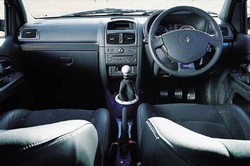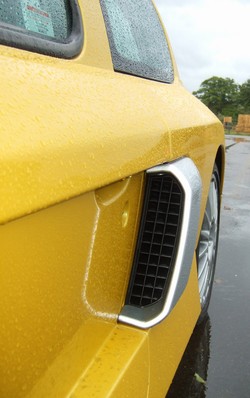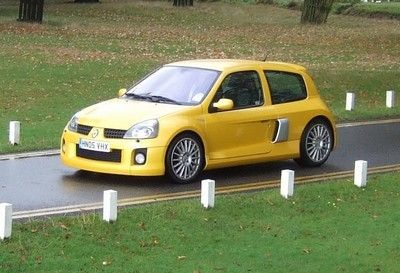clio rs
the truth about the clio v6 RENAULT CLIO V6 255
Renault tore up the rule book with the Clio V6 255. Ollie Stallwood drives a very different hot hatch...

There’s a point in the movie Men in Black where Will Smith and Tommy Lee Jones start zapping people to make them forget everything that has just happened. Looking at the Renault Clio V6 it seems likely that the same thing happened to its designers and engineers at an early stage in the car’s development.

How else would you explain the seeming disregard for practically every lesson learnt, every step forward, every trial and every error in the last twenty years of the hot hatch? Nothing about the car makes any sense. Why bother with rear-wheel drive when carmakers had finally learnt to harness huge amounts of power through a hatchback’s front wheels?
Why is the engine in the middle when this gave potential for impossible handling in such a short chassis? Why is it powered by a V6 when a turbocharged four could possibly be lighter and more effective? In fact the only normal thing about the car is the standard Clio dashboard, which incidentally looks completely bizarre in a car like this.
When Renault devised the Clio V6 Phase I it managed to completely tear up the rule book by making the car 300kg heavier than the quickest front-drive version of its hatchback, the 172 Cup. The V6 would provide more power but this would barely offset the weight advantage, and taking into account the wild handling you would easily be seen off by the younger brother for half the price.
The Phase II Clio V6 255 was rushed out quickly in a bid to rectify the fact that Renault had spent millions of pounds making a car go slower. Renault had given the Clio V6 a couple of tweaks: the wheelbase had been stretched by 23mm, there was a new rear subframe, the damper mounts had been repositioned and stiffened, TWR had reworked the suspension, the rear wheels had moved 15mm back, the trailing arms were lengthened by 10mm, a thicker anti-roll bar was added, and stiffer springs were thrown in. It really was nothing more than that.

At last the 255 would be the giant killer it always promised to be. Well, actually no. Renault couldn’t resist adding another 60kg just to blunt the extra 25bhp gained through a new ECU, better throttle assembly, different air filter and new camshafts and valves, which meant it now weighed a portly 1,400kg and the six second 0-60mph time didn’t really justify the looks.
So why is it then that everyone loved it, including Jeremy Clarkson, who picked it as one of his favourite cars of all time? Well, put it this way, if we all liked perfect, manufactured pop then Malcolm McLaren wouldn’t have bothered creating the Sex Pistols, and I for one am glad that he did.

I’m also glad that today I’m going to get to drive Phase II Clio V6 255. The car has a reputation of being a bit wayward, especially in the wet, and this is helping to sharpen my focus as I prepare to drive the Renault Heritage Centre treasured 9,000 mile example. It is one of an estimated eight RHD models in Acid Yellow, the colour glistening with every droplet of water that falls from the sky.
The shape of the Clio V6 is simply astonishing; to those in the know it is an unashamed classic, to others it is Ali G’s dream ride. I don’t know what this says about me but I absolutely love it. It is a riot of scoops and bulges, and the fact it is clearly a Clio makes it much cheekier.
When you open the door you realise where a lot of the extra weight must have come from. Underneath the plastic skin are standard Clio doors and panels and if you look closely you can see where and how the extended body has been tacked on.
Inside it is standard Clio fare, except for gearbox gaiter and lashings of suede on the door cards. That and the large Recaro buckets, of course, although once you have got comfortable in them you realise the driving position is standard Clio as well. The steering wheel doesn’t adjust for reach and instead you have to adopt a hunched, bus driver style which feels odd and is in perfect keeping with the rest of the car.

Turn the key and the 3.0-litre V6 takes a second to burst into life, sounding harder edged than you would imagine. The sensation of having the engine behind your head - the flat thrum accompanied by various competition-esque whirring noises - is strange, and surprising if you thought this was just going to be a smooth V6 shoehorned in.
The Clio doesn’t feel that quick from low revs and you sense the weight it is dragging around. In these conditions it almost seems like the lack of instant response has been engineered in to ensure there are no nasty surprises, stopping the wheels from breaking free unnecessarily.

As the revs rise the engine becomes an orchestra, steadily reaching a crescendo, the sound bouncing off the roof and the windows, filling the cabin in the same in the way you expect noise to clatter around the stripped-out cabin of a race car. It sounds high-pitched and intense, nothing like a V6 in fact, and at some points you could swear there are extra cylinders being thrown in.
Wring-out the engine and not only will you find where the performance is hiding but you may as well be in a full-blown race car accelerating down a straight. There are so many noises, and all of them combining to make a symphony of mechanical movement, with the backing track a washing machine of spin cycle.
It is so tempting to hold your foot down that you almost miss the frantic bobbing and weaving at the front of the car, mostly caused by the rear end being planted into the road. It is freakishly similar to the track-prepared Porsche 996 I drove the other day, the sound almost taking on a flat-six character.
As it is raining hard I am wary of this exotic layout in a car that has the proportions of Thunderbird 4 but in the interests of science I hunt out some twisties. Try to grab the Clio by the throat and it will fight back, resisting your cack handedness by spitting you out. The trick is to let the car flow, feathering power in progressively and treating it with respect.
Then it starts to make sense, working with you, and providing just enough mid-range thump to push you from corner to corner. There is no point in trying to aggressively slide it through the bends – mere mortals like me will end up in a tree – instead feeling for the limit of adhesion and pushing it a little each time.

The gearshift is light, with a long throw, and it is not the most precise, with any attempts of a quick change often catching out the synchromesh. What you do feel is utterly, utterly absorbed by the experience in a way other cars cannot match.
The twitchiness of the chassis – it feels like you could spin in a straight line if you tried hard enough – is absorbing, keeping you alert and desperate to learn more. You could own this car all your life and I bet you would never quite have the run of it – it is always one step ahead. This of course makes it one of the most thrilling drives of your life.

Flat out, palms sweating, ears ringing, you wonder how the hell this car is even road legal, or to put it another way how the hell it even exists. You almost feel like lamenting the fact that they don’t make them like this any more, but the truth is they did just three years ago.
I am totally smitten. It is a truly unique experience and so addictive it should be illegal. So what was the point? That’s just it: there is no point. Necessity needs compromise, and without compromise you get a Clio V6.
SORRY I SPELLED THE TITLE WRONG
Renault tore up the rule book with the Clio V6 255. Ollie Stallwood drives a very different hot hatch...
There’s a point in the movie Men in Black where Will Smith and Tommy Lee Jones start zapping people to make them forget everything that has just happened. Looking at the Renault Clio V6 it seems likely that the same thing happened to its designers and engineers at an early stage in the car’s development.
How else would you explain the seeming disregard for practically every lesson learnt, every step forward, every trial and every error in the last twenty years of the hot hatch? Nothing about the car makes any sense. Why bother with rear-wheel drive when carmakers had finally learnt to harness huge amounts of power through a hatchback’s front wheels?
Why is the engine in the middle when this gave potential for impossible handling in such a short chassis? Why is it powered by a V6 when a turbocharged four could possibly be lighter and more effective? In fact the only normal thing about the car is the standard Clio dashboard, which incidentally looks completely bizarre in a car like this.
When Renault devised the Clio V6 Phase I it managed to completely tear up the rule book by making the car 300kg heavier than the quickest front-drive version of its hatchback, the 172 Cup. The V6 would provide more power but this would barely offset the weight advantage, and taking into account the wild handling you would easily be seen off by the younger brother for half the price.
The Phase II Clio V6 255 was rushed out quickly in a bid to rectify the fact that Renault had spent millions of pounds making a car go slower. Renault had given the Clio V6 a couple of tweaks: the wheelbase had been stretched by 23mm, there was a new rear subframe, the damper mounts had been repositioned and stiffened, TWR had reworked the suspension, the rear wheels had moved 15mm back, the trailing arms were lengthened by 10mm, a thicker anti-roll bar was added, and stiffer springs were thrown in. It really was nothing more than that.
At last the 255 would be the giant killer it always promised to be. Well, actually no. Renault couldn’t resist adding another 60kg just to blunt the extra 25bhp gained through a new ECU, better throttle assembly, different air filter and new camshafts and valves, which meant it now weighed a portly 1,400kg and the six second 0-60mph time didn’t really justify the looks.
So why is it then that everyone loved it, including Jeremy Clarkson, who picked it as one of his favourite cars of all time? Well, put it this way, if we all liked perfect, manufactured pop then Malcolm McLaren wouldn’t have bothered creating the Sex Pistols, and I for one am glad that he did.

I’m also glad that today I’m going to get to drive Phase II Clio V6 255. The car has a reputation of being a bit wayward, especially in the wet, and this is helping to sharpen my focus as I prepare to drive the Renault Heritage Centre treasured 9,000 mile example. It is one of an estimated eight RHD models in Acid Yellow, the colour glistening with every droplet of water that falls from the sky.
The shape of the Clio V6 is simply astonishing; to those in the know it is an unashamed classic, to others it is Ali G’s dream ride. I don’t know what this says about me but I absolutely love it. It is a riot of scoops and bulges, and the fact it is clearly a Clio makes it much cheekier.
When you open the door you realise where a lot of the extra weight must have come from. Underneath the plastic skin are standard Clio doors and panels and if you look closely you can see where and how the extended body has been tacked on.
Inside it is standard Clio fare, except for gearbox gaiter and lashings of suede on the door cards. That and the large Recaro buckets, of course, although once you have got comfortable in them you realise the driving position is standard Clio as well. The steering wheel doesn’t adjust for reach and instead you have to adopt a hunched, bus driver style which feels odd and is in perfect keeping with the rest of the car.
Turn the key and the 3.0-litre V6 takes a second to burst into life, sounding harder edged than you would imagine. The sensation of having the engine behind your head - the flat thrum accompanied by various competition-esque whirring noises - is strange, and surprising if you thought this was just going to be a smooth V6 shoehorned in.
The Clio doesn’t feel that quick from low revs and you sense the weight it is dragging around. In these conditions it almost seems like the lack of instant response has been engineered in to ensure there are no nasty surprises, stopping the wheels from breaking free unnecessarily.

As the revs rise the engine becomes an orchestra, steadily reaching a crescendo, the sound bouncing off the roof and the windows, filling the cabin in the same in the way you expect noise to clatter around the stripped-out cabin of a race car. It sounds high-pitched and intense, nothing like a V6 in fact, and at some points you could swear there are extra cylinders being thrown in.
Wring-out the engine and not only will you find where the performance is hiding but you may as well be in a full-blown race car accelerating down a straight. There are so many noises, and all of them combining to make a symphony of mechanical movement, with the backing track a washing machine of spin cycle.
It is so tempting to hold your foot down that you almost miss the frantic bobbing and weaving at the front of the car, mostly caused by the rear end being planted into the road. It is freakishly similar to the track-prepared Porsche 996 I drove the other day, the sound almost taking on a flat-six character.
As it is raining hard I am wary of this exotic layout in a car that has the proportions of Thunderbird 4 but in the interests of science I hunt out some twisties. Try to grab the Clio by the throat and it will fight back, resisting your cack handedness by spitting you out. The trick is to let the car flow, feathering power in progressively and treating it with respect.
Then it starts to make sense, working with you, and providing just enough mid-range thump to push you from corner to corner. There is no point in trying to aggressively slide it through the bends – mere mortals like me will end up in a tree – instead feeling for the limit of adhesion and pushing it a little each time.

The gearshift is light, with a long throw, and it is not the most precise, with any attempts of a quick change often catching out the synchromesh. What you do feel is utterly, utterly absorbed by the experience in a way other cars cannot match.
The twitchiness of the chassis – it feels like you could spin in a straight line if you tried hard enough – is absorbing, keeping you alert and desperate to learn more. You could own this car all your life and I bet you would never quite have the run of it – it is always one step ahead. This of course makes it one of the most thrilling drives of your life.
Flat out, palms sweating, ears ringing, you wonder how the hell this car is even road legal, or to put it another way how the hell it even exists. You almost feel like lamenting the fact that they don’t make them like this any more, but the truth is they did just three years ago.
I am totally smitten. It is a truly unique experience and so addictive it should be illegal. So what was the point? That’s just it: there is no point. Necessity needs compromise, and without compromise you get a Clio V6.
SORRY I SPELLED THE TITLE WRONG
Last edited:

